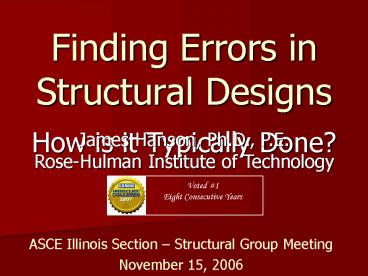Finding Errors in Structural Designs PowerPoint PPT Presentation
1 / 39
Title: Finding Errors in Structural Designs
1
Finding Errors in Structural Designs
- How is it Typically Done?
ASCE Illinois Section Structural Group
Meeting November 15, 2006
2
Overview
- Categories of Errors
- Experience of a Generation
- Shared Experiences
- Tools for Finding Errors
- Teaching Tools for Finding Errors
3
Categories of Errors
- Idealization of Reality
- Assumptions Inherent to Analysis or Design Method
- Roundoff Error
- Human Error
4
Idealization of Reality
5
Assumptions Inherent to Analysis or Design Method
Shear Strength
Code Design Eqtn
Concrete Beam Depth
6
Roundoff Error
7
Human Error
From AISC Seminar Field Fixes Common Problems
in Design, Fabrication and Erection Solutions
and Prevention
8
Overview
- Categories of Errors
- Experience of a Generation
- Shared Experiences
- Tools for Finding Errors
- Teaching Tools for Finding Errors
9
End of a Generation
- Precomputer engineers adept at finding errors
- Often called experience
- Will experience be lost?
10
Gathering Experience
- Ten Firms 1 - 700 engineers
- Interviewees 35 structural engr
- Experience 1-55 years
- PEs 29
- BS 8, MS 26, PhD 1
11
Interviews
Critical Incident 1 Think of the most recent
time you discovered something unreasonable in the
results of analysis or design.
Critical Incident 2 Think of the most alarming
time you discovered something unreasonable in
the results of analysis or design.
12
Overview
- Categories of Errors
- Experience of a Generation
- Shared Experiences
- Tools for Finding Errors
- Teaching Tools for Finding Errors
13
Post-tensioned slab-on-grade cracks. Followed
standard practice. Standard practice assumptions
were not valid in this case.
14
Beam through stairwell at chest
height. Accidentally left on drawings. Designer
failed to check drawings.
15
Detail not appropriate. Copied from previous
design. Reviewer recognized.
16
Beams meet without supporting column. Conditions
changed requiring removal of planned column, but
beams not redesigned. Found when checking load
paths.
C
B
CB
CB
A
1
3
4
2
17
Using in-house spreadsheet. Changing member
length had no effect on design strength.
Spreadsheet
had an error.
18
Beam flange not thick enough to weld studs. Beam
web too shallow to bolt to girder. Designed by
computer for strength. Found by experienced
reviewer.
19
Beams seemed too deep.
Checked reactions at ends of beam with hand
calculations.
Double counted self weight in computer design.
20
Foundation underdesigned. Forgot self weight of
structure. Remembered later.
21
Common Problem Structural layout does not match
architectural and/or mechanical layout. Changes
in layout not communicated by architect not
noticed by structural engineer. Will BIM fix
this?
22
Overview
- Categories of Errors
- Experience of a Generation
- Shared Experiences
- Tools for Finding Errors
- Teaching Tools for Finding Errors
23
Categories of Tools
- 1. Comparisons (23 of 87)
2. Rules of Thumb (7 of 87)
24
- 3. Visualization (5 of 87)
- 4. Other (14 of 87)
- Procedures
- Reflection
25
- 5. Previous Experience (22 of 87)
6. Field (14 of 87)
26
10 Quick Checks
- Is the deflected shape consistent with what was
expected? - Are the moment diagrams consistent with what was
expected?
Identifying Features
27
10 Quick Checks
- Does the building weigh what you anticipate?
- Does total base shear equal total applied lateral
load?
Checking Equilibrium
28
10 Quick Checks
- Do beams deflect more than permitted?
- If most beams are the same size, why are others
not? - Is the beam depth consistent with standard
rules-of-thumb?
29
10 Quick Checks
- Do the connections and bracing provide a
continuous load path? - Do connection details match the assumptions used
in the analysis? - Are the primary structural member sizes similar
in similar projects?
30
Overview
- Categories of Errors
- Experience of a Generation
- Shared Experiences
- Tools for Finding Errors
- Teaching Tools for Finding Errors
31
Teaching the New Generation
- Many firms do so informally
- Not in textbooks
- Integrating at undergrad level
32
Learning the Tools
- Comparisons
- Rules of Thumb
- Visualization
- Other
- Previous Experience
- Field
Procedures
Over Time
Least Preferred
33
Integrating Into Classroom
- Emphasize approximations
- Equilibrium always satisfied
- Features of behavior
34
Approximations
Situation The roof shown experiences snow load
with drifting adjacent to the AC unit. The
resulting distributed load on member AB is shown.
300 plf
100 plf
100 plf
A
B
50 plf
AC Unit
A
B
10 ft
5 ft
10 ft
5 ft
Plan View
Objective Find, approximately, the peak moment
and shear experienced by member AB.
35
Equilibrium
36
Features of Behavior
Situation A simply supported beam with a
cantilevered end experiences uniform distributed
load.
Objective Construct the moment diagram.
Identify at least four features of the diagram
that suggest you have a reasonable solution.
37
Impact In Classroom
38
Summary
- Some errors not tolerated
- Tools for finding them
- Tools passed on informally
- Tools can be taught
Center for Structural Engineering
Education www.rose-hulman.edu/csee
39
Acknowledgements
Sponsor Grant DUE-0341212
Participating Firms
Questions or comments james.hanson_at_rose-hulman.ed
u

